Chongqing Cultural Picture | Manxingji of Daxigou Trail Group

Every outsider will be amazed by the terrain here when they first enter Yuzhong: towering skyscrapers grow layer by layer in the mountains along the Jialing River and the Yangtze River, soaring into the sky; The bridges on the river and the overpasses on land crisscross and spiral upwards, creating a dazzling yet unique scenery; The light rail of Liziba passes through the buildings, running all the way on the river and by the mountains, full of vitality
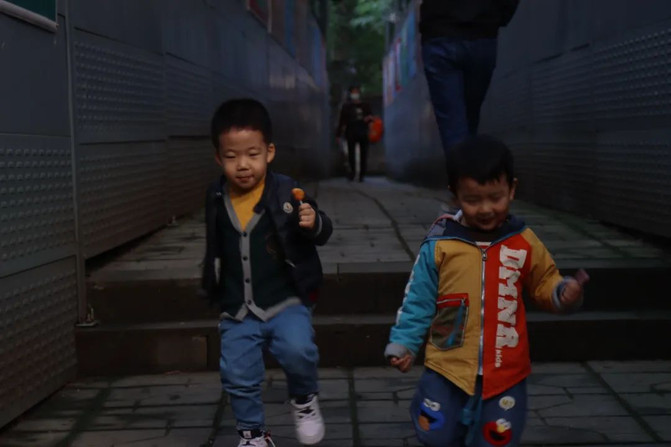
This is a city built on a mountain, where the mountain is the city and the mountain is the city.
Mountains and cities complement each other.
In order to match the urban terrain and adapt to local conditions as much as possible, architects distributed everything that belonged to the city, including buildings, commerce, transportation, and daily life, in various locations up and down the mountain. Therefore, there was the concept of an upper half city and a lower half city. Today, this has become the origin of the name of the 8D city in Yuzhong.

The Shancheng Trail was the inevitable route that connected the mountains and the foothills back then.
If Monument to the people's Liberation, Chongqing Raffles and Longhu Chongqing Shidai Sky Street are the A side of Yuzhong District, then the footpath hidden in the urban texture is the B side of Yuzhong District. Only when you truly delve into Yuzhong and explore the cultural heritage and historical memories here, will you discover that these trails that connect the upper and lower halves of Yuzhong District are the true moonlight treasure boxes that capture time.

More importantly, these trails still retain their original functions, not only as Yuzhong in the eyes of tourists, but also as a truly living part of Yuzhong. Standing on these historic mountain city trails, you can truly feel the connection of time.

For tourists, these are just roads. But for the residents living here, it is a lifetime.
So, some people see the Mountain City Trail as a negative image of Yuzhong. They say that on these trails, one can see qualities such as stubbornness, hard work, perseverance, as well as optimism and inclusiveness.

Daxigou Street is located in the central northern part of Yuzhong District. Due to its topographical features, there are six mountain city trails hidden in its streets and alleys.

In the early winter afternoon, holding umbrellas and diving into the fluttering rain curtains, we walked towards these trails.
We entered the deepest part of the texture of Yuzhong.
01 The Taste of Books - Zhangjia Garden Mountain City Trail
Location: Chongqing People's Hospital extending upwards from Renhe Street to Zhongshan Second Road

From the intersection next to the Municipal People's Hospital, you will enter the Zhangjia Garden Trail. As I first entered the trail, a strong scent of books rushed towards me.
The Zhangjia Garden Trail is a part of the third trail in the mountain city, named after Zhangjia Garden, which was first built during the Republic of China period.

The trail winds back and forth, with walls made of green bricks and white gray joints. Large stone steps extend downwards to form various corners - this is a corner full of surprises. Almost every turn, different scenery appears in front of you.

This is the most typical living area in Chongqing. Along both sides of the trail, residential buildings stand tall, with mottled walls and building shapes silently recording the smoke and clouds of time passed by the old community. Occasionally, there is a small pedestrian bridge that leads from the trail into the nearby residential building. Along the fence built along the trail, there are several dark red benches interspersed for visitors or citizens to rest.

The community environment and living facilities of the entire Zhangjia Garden Trail are very complete. Along the trail, there are kindergartens, nursing homes, vegetable markets, braised food shops, and even cotton picking and locksmith shops that are difficult to see outside... The residents are peaceful, calm, and composed, with a contented expression, walking slowly and feeling calm inside.

This not too long trail has once carried countless familiar names and the glory of Chongqing city.
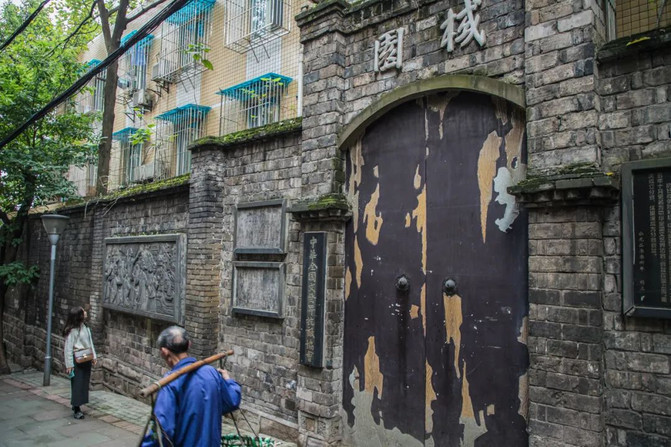
The Bashu Kindergarten on the trail was formerly known as Zhangjia Garden Orphanage. One of the directors, Li Yiming, was the uncle of Red Rock martyr Jiang Jie, who also received the earliest communist ideological education here.

At No. 65 Zhangjia Garden, above the blue brick courtyard gate, there are two traditional Chinese characters: "Yuyuan". This is the former dormitory of Bashu Middle School, which was leased to the Chinese National Association of Literary and Art Circles Against the Enemy established by Zhou Enlai, Sun Ke, and Chen Lifu in 1938. From then on, this small place became the center of the national literary and artistic circles during the Anti Japanese War.

Through this door, Lao She, dressed in long robes, and Bing Xin, dressed in cheongsams, once gathered elites in the national literary and artistic circles such as Mao Dun, Ba Jin, Hu Feng, Zhu Ziqing, Ding Ling, and Tian Han. Now, only a mottled old wooden door remains for future generations to stop and reminisce.

In the former site of Bashu Middle School, Lu Zuofu, Kang Xinru, and He Lu established the school motto of "fairness, sincerity, and simplicity". Premier Zhou Enlai once gave the famous speech "Nine Questions on the Anti Japanese War" on the playground of Bashu School. Famous educator Ye Shengtao served as a Chinese language teacher here, and the school song with lyrics has been sung to this day. Lao She, Guo Moruo, Zou Taofen, Tian Han, Hu Feng, Shao Lizi, Shen Junru and other revolutionary predecessors once held dozens of anti Japanese war speeches here. Nearly a century later today, Bashu Middle School has relocated to a more convenient location for education, continuing its glory. On the old site next to the Zhangjia Garden Trail, only the school gate, constructed with four white Roman columns and beams, still stands there.

On the path of the Zhangjia Garden, there is also the site of the "Sino French School", which is of great historical significance to the CPC. "Sino French School", founded in 1925 by Mr. Wu Yuzhang, a revolutionist and educator, is the first cadre training school of the CPC in CPC and the birthplace of Chongqing Branch, the earliest party organization in Chongqing.
02 City Light - Zaozi Lanya Zaoyi Lane Trail
Location: Located in the north of the People's Great Hall, connecting Zaozilanya Main Street and Zhongshan Second Road. If the Zhangjiahuayuan Mountain City Trail is dominated by the scent of books in shades of blue and gray, then Zaozilanya Zaoyixiang Trail is colorful and vibrant.

This is a somewhat steep trail, although I haven't measured the overall drop, the 288 step staircase makes the trail somewhat daunting when viewed from above - if someone slips off the stone ladder and falls, the nearly 40 degree slope will make the entire situation somewhat unbearable.

At the same time, this trail was originally paved with large bluestone. During the rainy season in Chongqing, which often lasts for a month in autumn and winter, this material is prone to the growth of moss - the standard "slippery road in rainy weather". So, this place was once called "Devil's Ladder" by the old residents of Zaozilanya.
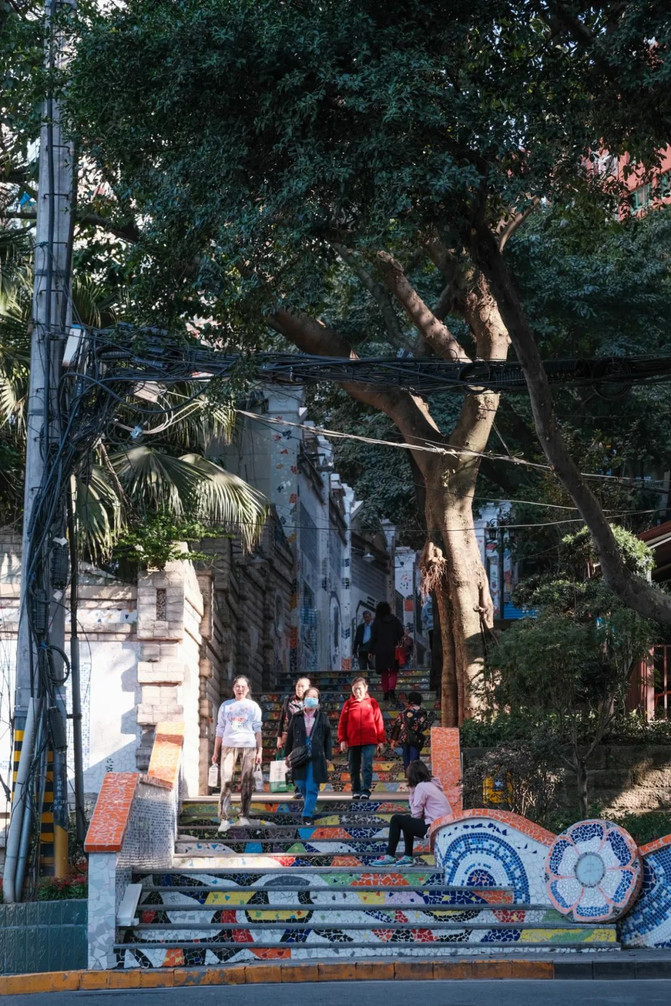
In order to improve this situation, the government has renovated the Zaoyi Lane Trail. In addition to using anti slip materials as the main material for the ground, the facade of the stone staircase and the walls of the walkway are decorated with mosaic and colored veneered tiles. This is not just a simple color scheme, compared to trendy graffiti works.

Looking up from the bottom of Zaoyi Lane footpath, the facades of the stairs create iconic landscapes: the Monument to the people's Liberation with surging crowds of people, the rail transit passing through the building, the Yangtze River cableway led by the flying line, the Hongya Cave with the same style as Qianyou Qianxun, and the Chongqing Cultural Landmark Chongqing People's Auditorium. Every season in Chongqing has its own color, but the color of Zaoyi Lane is colorful all year round.
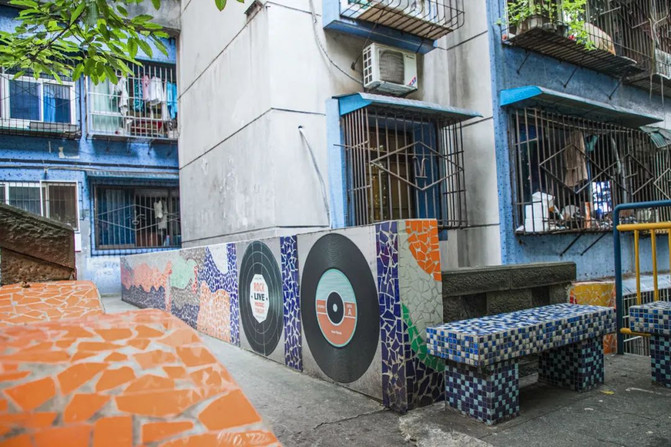
On the wall on one side of the trail, with the theme of "In Time", the representative symbols of each era since the reform and opening up are integrated into every brick and tile of the alley by embedding bright colored tiles. Mobile phones, mobile phones, and portable music players... Despite the rapid changes in times and life, people of each era can still find the imprint of time here. Time is the driving force, and the power emanating from it is the core of the city's endless vitality.

On the other side of the trail is a residential building. Along the trail, small buildings built in the 1980s and 1990s are hidden among the dense yellow kudzu trees on the roadside. The yellow kudzu trees, the trunks of which one person hugged and the canopies that could cover almost the entire trail, showed no signs of decay under the autumn and winter drizzle. Instead, they were supported by the colorful hues of the entire alley, making them vibrant and bright. Perhaps this will become a new check-in spot for Chongqing tourism in the future.
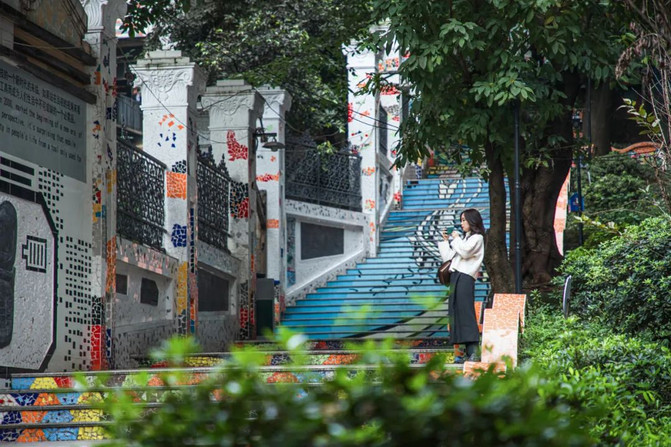
03 Slow Time - Zaozi Lanya Zao Er Lane Trail
Location: Hidden between an old residential building next to Chongqing No. 42 Middle School, connecting Renhe Street and Zaozilanya Main Street. The entrance of Zao Er Lane Trail is located next to Shuxiang Garden in Huafu Lane Community, adjacent to No. 42 Middle School. It leads up to the back door of Chongqing Medical University Affiliated Children's Hospital on Zaozi Lanya Street, with a length of about 300 meters. It was once the main passage for walking from Renhe Street to Guanyin Rock, Cultural Palace and other places.

Entering now, it's hard to imagine the scenes of the past. Before renovation, the pipelines here were disorderly, the walls were mottled, and garbage was scattered everywhere

The renovation and upgrading of Zao Er Lane Trail was completed in the first two years. But this is not a simple renovation, but a restoration that incorporates the characteristics of the mountain city and the core cultural elements of filial piety. In fact, such an atmosphere can be felt as soon as you walk into Zao Er Lane Trail.

The mottled walls have been repaired into a light toned wall with blue bricks and white gray joints, while the buildings next to the walkway where the walls cannot be replaced have been painted with bright yellow wall paint. On the electric poles in the trail, paintings depicting the hanging buildings or old buildings in Yuzhong have been painted, and even on the distribution boxes, different themes such as plum blossoms, orchids, bamboo, and chrysanthemums have been painted. This makes people feel like they have instantly stepped into traditional Chinese painting.

The entire Zao Er Lane trail gives a particularly elegant feeling, coupled with the old school gate of Chongqing No. 42 Middle School and the nearby Peach and Plum Garden on the side of the trail, it exudes the style of Chongqing's mother city.

No. 1 Zao Er Lane in the middle section of the trail is a courtyard transformed from a 300 square meter residential courtyard into a benevolent and filial piety cultural courtyard. The small courtyard is equipped with fitness equipment and convenient chairs, and the walls are painted with the theme of "24 Filial Piety" and the culture of filial piety. The sketch mural of the light rail passing through the building at the corner of the courtyard is very three-dimensional, and the green plants next to it are kept in a water tank. Although the water tank is somewhat damaged, when it appears here, it is like adding the finishing touch, making the entire mural and painting come to life at once.
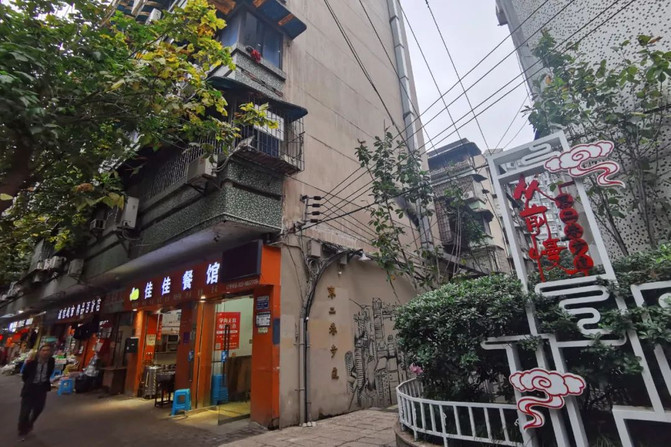
Living here is also particularly comfortable. The walls are made of green bricks, and the steps are made of stone slabs. Several large trees provide shade in front of and behind the walls, and orange fat cats occasionally come into view. After the rain, the leaves of the green vines drip and leave water. Walking people then climb up the stone stairs, greeting each other all the way.

Think of Mu Xin's song "Once Upon a Time Slow": remember when I was a teenager/everyone was sincere/said one word/yes one word/the railway station in the morning/the long street was dark and pedestrian free/the shop selling soybean milk was steaming hot/the former sun became slow/cars, horses, mail were slow/life was only enough to love one person/the old locks were also beautiful/the keys were beautiful/you locked them/people would understand.

04 The Tranquility of Time - The Eighth Trail of Mountain City
Location: Starting from the 829 bus stop on Renhe Street, extending upwards to Zaozilanya in Hongqiu Dam, connecting to Wenhua Palace Lane, and finally reaching the outpatient department of Zhongshan Second Road Children's Hospital.

The Eighth Trail of Shancheng may be the most complex trail in Yuzhong District, connecting the People's Cultural Palace, Xuetian Bay, and Daxigou Road, with a total length of about 1 kilometer.

Some out of town tourists found themselves completely confused when they walked in here, wondering which path to turn in the direction they needed. But for residents living in the area, after the completion of the renovation of the eighth trail in the mountain city, this place has become a well connected place: "People who are not familiar with the road may think that our place is remote, but if you are familiar with the road, it is very convenient to go anywhere. Zaozilanya, Ma'anshan, and Cultural Palace are all within a few minutes' walk

The scenery along the trail is beautiful, and the quiet roads are covered with bluestone slabs. There are many trees on both sides of the trail, and the tree crowns are high and dense. Even in summer, the tree lined path is not hot. Compared with other trails, the color of the eighth trail in the mountain city is particularly striking - red brick walls with green and black tiles on top, thick yellow kudzu trees growing from the roots of the walls on both sides, matched with old Chongqing prints on the walls, like time turning and turning.

On the other side of the road, the brick red wall is flanked by green tiles. Although the colors collide, they collide extremely retro, adding a touch of classical flavor.
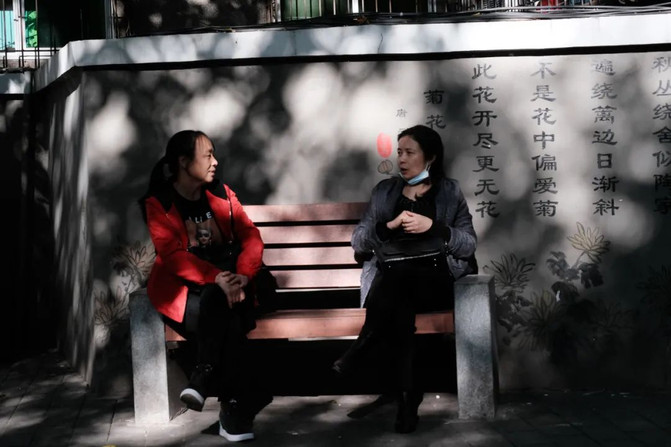
The prints on the walls almost exclusively depict the scenery of old Chongqing, such as the Linjiangmen Pier and Wanglongmen Cable Car, which are memories of a generation of Chongqing people. This is undoubtedly the best communication material for both the new generation of Chongqing residents and foreign tourists.

Because this is a trail within the old residential area, most of the people who often walk in it, apart from tourists, are acquaintances. As they walked, people's footsteps slowed down a lot. Occasionally, they would greet acquaintances who walked across from them. When they passed by their old friend's doorstep, they would shout and wake up the old man who was dozing off with narrowed eyes on the lounge chair at the door. They then made an appointment with their old friend to dance the dam dance at night and left. Walk calmly, neither happy nor sad.

From top to bottom, there is a trail that is only that long. We have to pass through here to go to work, and we have to pass through here to go home. Even for dating and getting married, we still have to pass through here. The walls turned red, the tiles turned green, the ground became neat and smooth, and the yellow kudzu trees grew up again.

There is less noise, and time is calm.
Time records stories here. Time is quiet, as usual.
Previous Article:Where to go on weekends, follow in the footsteps of the uncle and wander around Rongchang
Next Article:Chongqing, can you change the name of 'Magic City' with Shanghai?
